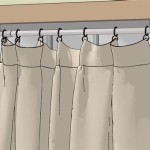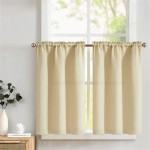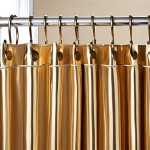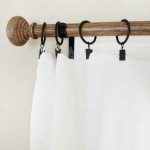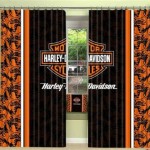Extra Wide Pinch Pleat Curtains: A Comprehensive Guide
Extra wide pinch pleat curtains represent a sophisticated and functional window treatment solution, especially well-suited for expansive windows and large rooms. The pinch pleat heading, characterized by its elegant gathers and structured folds, provides a tailored and polished look that elevates the aesthetic of any space. When combined with extra wide fabric widths, these curtains effectively address the challenges of covering over-sized windows without the need for multiple panels and visible seams, ensuring a continuous and visually appealing drape.
The demand for extra wide pinch pleat curtains stems from the growing popularity of open-concept living spaces, larger windows designed to maximize natural light, and the desire for window treatments that offer both style and superior functionality. These curtains not only enhance privacy and light control but also contribute significantly to the overall thermal efficiency of a room, helping to regulate temperature and reduce energy consumption. Understanding the nuances of fabric selection, pleat styles, hardware requirements, and installation techniques is crucial for achieving the desired aesthetic and ensuring the longevity of these window treatments.
This article will explore the various aspects of extra wide pinch pleat curtains, providing comprehensive information to assist in making informed decisions regarding their selection, specification, and implementation. It will delve into fabric considerations, pleat style options, hardware and installation requirements, and other relevant factors that contribute to the successful integration of these curtains into a residential or commercial setting.
Fabric Selection for Extra Wide Pinch Pleat Curtains
The choice of fabric is paramount when selecting extra wide pinch pleat curtains, as it significantly impacts the overall aesthetic, functionality, and durability of the window treatment. Considerations extend beyond mere color and pattern, encompassing factors such as weight, texture, opacity, and maintenance requirements.
Weight and Drape: Heavier fabrics, such as velvet, brocade, or thick linen blends, offer superior drape and light-blocking capabilities. They create a luxurious and formal appearance, making them ideal for bedrooms, living rooms, or home theaters. Lighter fabrics, such as voile, sheer linen, or lightweight cotton, allow more natural light to filter through, creating a breezy and airy ambiance. These fabrics are suitable for spaces where privacy is less of a concern, such as sunrooms or breakfast nooks. The weight of the fabric needs to be carefully considered in relation to the curtain hardware to ensure proper support and prevent sagging.
Opacity and Light Control: The opacity of the fabric determines the degree of light control and privacy offered by the curtains. Blackout fabrics provide complete light blockage, ideal for bedrooms or media rooms where darkness is desired. Dim-out fabrics reduce light transmission, creating a softer and more diffused light. Sheer fabrics offer minimal light control and privacy, allowing maximum light to enter the room while providing a degree of visual screening. Layering different fabric opacities can provide a versatile solution, allowing for adjustable light control and privacy levels. For example, a blackout lining can be added to a decorative fabric to enhance its light-blocking capabilities.
Texture and Pattern: Texture adds visual interest and depth to the curtains. Smooth fabrics, such as silk or satin, create a sleek and elegant look, while textured fabrics, such as linen or woven blends, offer a more relaxed and natural feel. The pattern of the fabric should complement the existing décor of the room. Large-scale patterns can make a bold statement, while smaller-scale patterns offer a more subtle and understated appeal. Solid-colored fabrics provide a versatile backdrop that can easily be integrated into a variety of design schemes. When selecting patterned fabrics, it is essential to ensure that the pattern repeat is compatible with the width of the curtain panel to avoid awkward or uneven pattern placement.
Maintenance and Durability: The maintenance requirements of the fabric should be considered, especially in high-traffic areas or homes with children or pets. Fabrics that are stain-resistant, wrinkle-resistant, and machine-washable offer greater convenience and longevity. Delicate fabrics, such as silk or velvet, may require professional cleaning. The durability of the fabric is also important, especially for curtains that will be exposed to direct sunlight. Fabrics that are prone to fading or degradation should be avoided. Consider the fiber content of the fabric, as natural fibers tend to be more breathable and comfortable, while synthetic fibers offer greater durability and stain resistance. A blend of natural and synthetic fibers can provide a good balance of comfort, durability, and ease of maintenance.
Pinch Pleat Styles and Considerations
The pinch pleat style significantly impacts the overall look and feel of the curtains. Different pleat styles offer varying degrees of fullness, formality, and stacking ability. Selecting the appropriate pleat style is crucial for achieving the desired aesthetic and ensuring that the curtains hang properly.
Types of Pinch Pleats: The most common types of pinch pleats include the three-finger pleat, the two-finger pleat (also known as a French pleat), and the goblet pleat. The three-finger pleat is the most traditional and versatile option, creating a full and gathered look. The two-finger pleat offers a more streamlined and modern appearance. The goblet pleat is more formal and structured, creating a rounded, goblet-shaped top. The choice of pleat style depends on the desired level of formality and the overall aesthetic of the room.
Fullness and Stack Back: The fullness of the curtains, which refers to the amount of fabric used relative to the width of the window, affects the drape and fullness of the pleats. A general rule of thumb is to use two to three times the width of the window for optimal fullness. The stack back, which refers to the amount of space the curtains occupy when fully open, should also be considered. Fuller curtains will require more stack back space. Insufficient stack back can obstruct the window and reduce the amount of natural light entering the room.
Pleat Spacing and Depth: The spacing between the pleats and the depth of the pleats affect the overall appearance of the curtains. Closer pleat spacing creates a more gathered and formal look, while wider pleat spacing offers a more relaxed and casual feel. Deeper pleats create a more pronounced and structured fold, while shallower pleats offer a softer and more subtle effect. The pleat spacing and depth should be proportional to the size of the window and the weight of the fabric.
Customization and Considerations: Customized pleat styles can be created to achieve a unique and personalized look. These can be spaced or grouped in diverse ways to create a modern or unique style. The type of heading tape used will influence the formation and stability of the pleats. High-quality heading tape will ensure that the pleats maintain their shape and integrity over time. The placement of the pleats should be carefully considered to ensure that they are evenly spaced and aligned. Professional curtain makers can provide expert guidance on pleat style selection and customization.
Hardware and Installation for Extra Wide Pinch Pleat Curtains
The hardware used to hang extra wide pinch pleat curtains must be sturdy and durable enough to support the weight of the fabric. Proper installation is crucial for ensuring that the curtains hang properly and operate smoothly. Incorrect hardware or installation can lead to sagging, uneven draping, and premature wear and tear.
Curtain Rods and Tracks: The choice of curtain rod or track depends on the weight of the curtains and the desired aesthetic. Heavy-duty curtain rods made of metal or wood are recommended for extra wide pinch pleat curtains. Curtain tracks offer a more streamlined and modern look and allow for smoother operation, especially for very heavy curtains. The diameter of the curtain rod should be sufficient to prevent sagging, and the brackets should be securely mounted to the wall or ceiling. For extra wide windows, it may be necessary to use multiple brackets to provide adequate support. Tracks are generally preferred for extra wide and heavy curtains as they distribute the weight more evenly and provide a smoother gliding action.
Curtain Hooks and Rings: Pinch pleat curtains require special hooks that are inserted into the back of the pleats. The hooks are then attached to the curtain rod or track. The type of hook used depends on the type of curtain rod or track. For curtain rods, rings with eyelets are used to attach the hooks to the rod. For curtain tracks, special gliders or carriers are used to attach the hooks to the track. The hooks should be securely attached to the pleats to prevent them from slipping or detaching.
Installation Techniques: Proper installation is essential for ensuring that the curtains hang properly and operate smoothly. The curtain rod or track should be installed at the correct height and distance from the window. The brackets should be securely mounted to the wall or ceiling, ensuring that they are level and aligned. The curtains should be hung evenly and adjusted to ensure that they drape properly. It may be necessary to steam or iron the curtains after installation to remove any wrinkles or creases. For extra wide windows, it is often recommended to hire a professional installer to ensure that the curtains are properly installed.
Additional Considerations: Consider the use of tiebacks or holdbacks to keep the curtains open during the day. Tiebacks can be made of fabric, rope, or metal and should complement the style of the curtains. Holdbacks are typically mounted to the wall and are used to hold the curtains in place. The placement of tiebacks and holdbacks should be carefully considered to ensure that they do not obstruct the window or interfere with the operation of the curtains. For motorized curtain systems, the installation process will require specialized expertise and equipment. Ensure that the electrical components are properly installed and connected.

Extra Wide Double Pinch Pleated Faux Linen Curtains 28 Colors Custom Size Drapery Panels For Living Room Bedroom Rod And Track Etsy Australia

Exclusive Fabrics Furnishings Signature Misty White Plush Velvet Extrawide Hotel Blackout Rod Pocket Curtain 100 In W X 84 L 1 Panel Vycso16120244d The Home

Liz Linen Extra Wide Curtains Twopages

Extra Wide Double Pinch Pleated 100 Blackout Curtains 42 Colors Free Tiebacks Rod Pocket Multifunctional Tape Curtain Track Etsy

Windsor Linen Cotton Striped Curtain Pinch Pleat Chadmade Curtains

Extra Wide Double Pinch Pleated Faux Linen Curtains 28 Colors Custom Size Drapery Panels For Living Room Bedroom Rod And Track Etsy Australia

Next Grey Silver Cotton Blackout Thermal Pencil Pleat Curtains 228wx229d Adult

Extra Wide Triple Pinch Pleated 100 Blackout Curtains 42 Colors Free Tiebacks Rod Pocket Multifunctional Tape Curtain Track Etsy Uk

Exclusive Fabrics Furnishings Nomad Tan Beige Faux Linen Extra Wide 108 In L X 100 W Room Darkening Rod Pocket Curtain 1 Panel Bchln18538 108d The Home

Chadmade Extra Wide Curtain 100 W X 84 L Polyester Linen Drape With Blackout Lining Pinch Pleat For Sliding Door Patio Living Room Bedroom 1 Panel Beige White Tallis Collection


